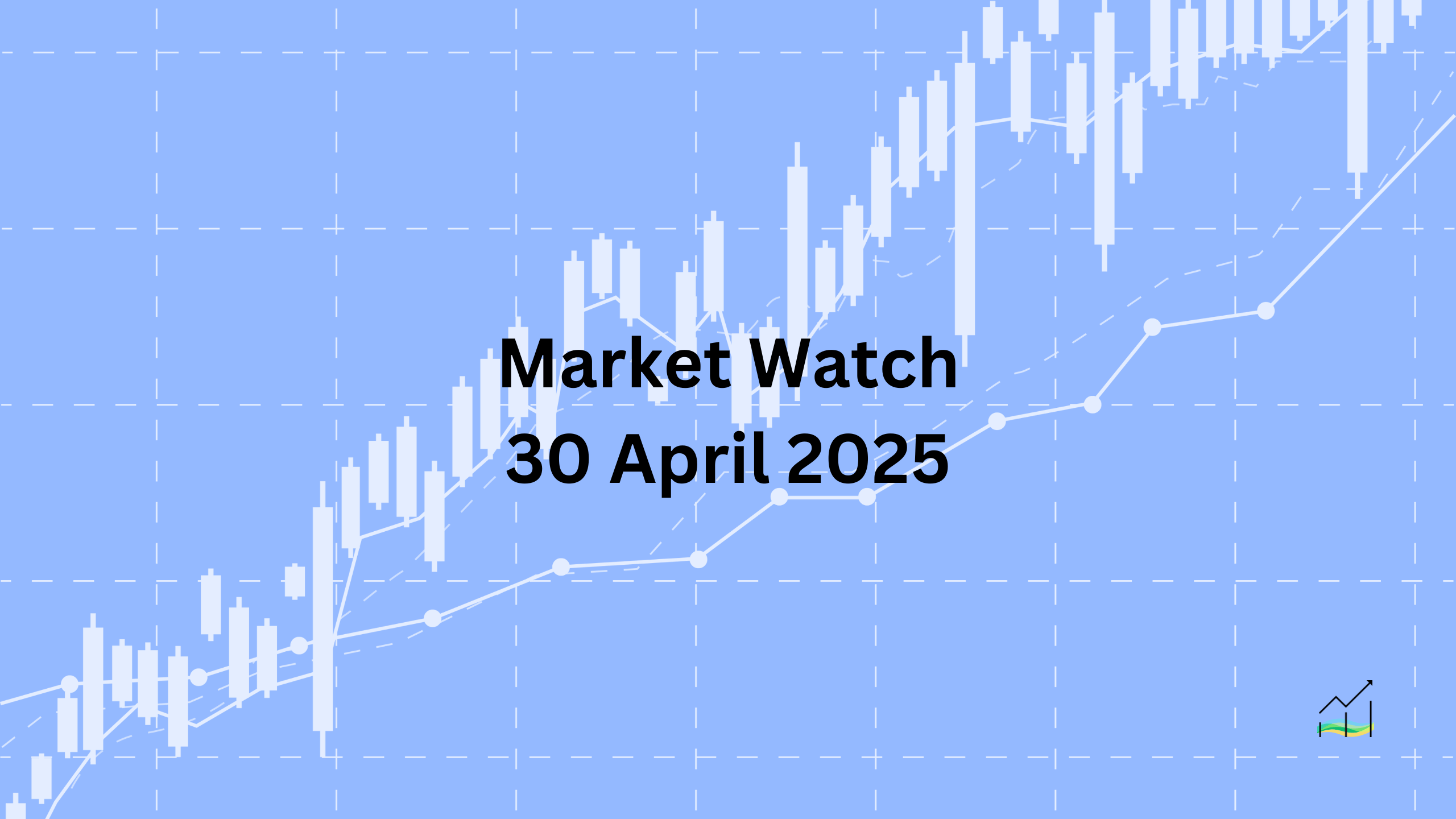30/04/2025 Market Watch

Dollar Steady in Quiet Market as Eurozone GDP Beats Forecasts
Key Takeaways:
- USD remains largely unchanged across G10; yen and sterling weaken.
- EM Asia FX firms, CE Europe lags despite strong eurozone GDP.
- PBOC continues to guide yuan stronger ahead of May Day holiday.
- Equities mixed: APAC mostly green, China lags; Europe rallies for 7th day.
- US yields dip; gold and oil extend declines.
The foreign exchange market opened the week on a quiet note, with the US dollar showing minimal movement against its G10 counterparts. Dollar-bloc currencies are slightly firmer, while the yen and British pound are under pressure, losing 0.5% and 0.35% respectively. In emerging markets, Asia Pacific currencies are holding steady to higher, while Central European currencies are soft, potentially dragged by the euro, despite a surprisingly strong Q1 eurozone GDP print of 0.4% — likely outperforming the upcoming US figure.
China’s central bank continued to guide the yuan stronger, setting the dollar reference rate lower for the fifth straight session ahead of the May Day holiday. Meanwhile, lingering trade policy revisions from the US surfaced late yesterday, as former President Trump modified auto tariffs, carving out exemptions for steel and aluminum and offering relief for imported components used in US-made vehicles.
On the equities front, Asia Pacific markets were broadly higher, though China underperformed. The Euro Stoxx 600 is on track for a seventh consecutive gain, while US futures are soft. In fixed income, benchmark 10-year yields across Europe are 3–4 basis points lower, while the US 10-year yield has slipped to 4.16%, down from last week's 4.23% close.
Gold prices are on the defensive for a second session, nearing Monday's low near $2,268. Crude oil (WTI June) remains under pressure, trading near $59.20 — the weakest level since April 11 — although some recovery is seen in European hours.
United States of America
Overview
The Dollar Index continues to trade within a narrow consolidation range, currently hovering between 98.85 and 100.00. This week’s range is even tighter, established between 98.90 and 99.85. Despite upward momentum in technical indicators, there is growing tension as softer real-sector data is expected to emerge. Today is a key moment for US economic readings, with high-impact data likely to reflect the softness already seen in earlier surveys. The market’s focus is on whether these figures will confirm signs of stagnation or outright contraction in Q1.
A particular point of interest lies in gold imports. A surge in US gold inflows—potentially for financial rather than industrial purposes—may not be fully captured in traditional trade metrics. This distortion could mask deeper economic weakness. According to the Atlanta Fed's GDPNow tracker, even when adjusted for financial gold, the US economy may have contracted by 0.4% in the first quarter. A more accurate gauge of domestic economic health—final sales to private domestic purchasers—is estimated to be growing at just 1.4%, nearly half the pace seen in Q4 2024.
Economic Drivers
- Dollar Index consolidates in a tight range amid mixed signals.
- Momentum indicators suggest potential upside, but real-sector data may contradict.
- Surge in gold imports may distort GDP calculations.
- Markets anticipate confirmation of economic stagnation or contraction.
- Atlanta Fed GDPNow indicates Q1 contraction of -0.4%.
- Final private domestic sales likely slowed to 1.4% (vs 2.8% in Q4).
Data and Events
- 1 May 2025 – ADP Employment Report: Expected at +115k (prev. +155k).
- 1 May 2025 – Q1 2025 GDP (Advance): Expected flat; Atlanta Fed sees -0.4%.
- 1 May 2025 – Initial Jobless Claims: Weekly update.
- 1 May 2025 – Chicago PMI (April): Regional business activity index.
Price Action
- DXY range-bound, capped below 100.00.
- Technical indicators lean bullish, but macro risks limit upside.
- Treasury yields slightly softer; 10Y near 4.16%.
- Market awaits confirmation from GDP and ADP for next directional move.
Key Points:
- Dollar Index remains in consolidation despite bullish momentum.
- All eyes on US GDP and ADP jobs data for confirmation of slowdown.
- Atlanta Fed sees potential Q1 contraction despite gold import distortions.
- Domestic demand growth slowing sharply from late 2024 levels.
Australia
Overview
After reaching its strongest level since December near $0.6450, the Australian dollar has reversed lower, slipping to around $0.6375. Although it held above Monday’s intraday low, the currency settled on a weak footing. So far today, it remains range-bound near $0.6400, but any break below $0.6350 could confirm the start of a broader correction. The initial downside target lies around $0.6290–$0.6300, with deeper potential toward $0.6250 in the near term.
On the macro front, Q1 inflation figures showed some easing in underlying price pressures, despite headline CPI remaining steady at 2.4% year-over-year. The Reserve Bank of Australia is likely to welcome this moderation. The trimmed mean CPI fell from 3.3% to 2.9%, and the weighted median eased from 3.5% to 3.0%. With inflation now clearly trending lower, the RBA appears increasingly poised to accelerate its easing cycle. Futures pricing suggests a 25 bp rate cut is likely at each of the next three meetings, with a total of 115 bp of easing projected for the remainder of 2025.
Economic Drivers
- AUD retreats from 5-month high as correction risk grows.
- CPI steady at 2.4% y/y; core measures (trimmed mean, weighted median) ease notably.
- RBA likely to welcome disinflation trend, opening door for rate cuts.
- Futures market prices in 115 bp of easing by year-end.
- First rate cut expected as early as May.
Data and Events
- 1 May 2025 – Building Approvals (March): Monthly housing activity update.
- 2 May 2025 – Trade Balance (March): Key export/import data.
Price Action
- AUD/USD retreats from ~$0.6450 high toward $0.6375.
- Technical bias turns bearish on break of near-term support.
- Watch $0.6350 for downside confirmation; next target ~$0.6290–$0.6300.
- Momentum aligned with policy easing expectations.
Key Points:
- AUD failed to hold breakout above $0.6450 and is reversing lower.
- Inflation moderates, especially core measures — a dovish signal for RBA.
- Markets now pricing aggressive easing path through year-end.
- Bearish price structure emerging below $0.6400.
Canada
Overview
The Canadian dollar has shown little movement over the past week, with the USD/CAD pair mostly confined to the 1.38-handle. Trading has been narrow, ranging slightly above CAD1.3820 to around CAD1.3845. Despite the consolidation, momentum indicators continue to lean in favour of an upside break, with potential for the pair to extend toward the CAD1.4000 level.
On the data front, February GDP is expected to come in flat following a 0.4% expansion in January. However, caution is warranted when extrapolating monthly GDP data to quarterly trends. In Q4 2024, cumulative monthly growth totaled 0.3%, yet the quarterly figure came in at a much stronger 2.6% annualised. For Q1 2025, the market anticipates a slowdown, with Bloomberg’s median forecast pointing to 1.8% annualised growth.
Economic Drivers
- February GDP expected flat after strong January.
- Monthly GDP data not always a reliable proxy for quarterly trends.
- Growth forecast for Q1 2025 slows to 1.8% annualised (vs 2.6% in Q4 2024).
- Market sensitive to shifts in US-Canada yield differentials and oil prices.
Data and Events
- 30 April 2025 – February GDP: Forecast flat (prev. +0.4%).
- 2 May 2025 – S&P Global Manufacturing PMI (April): Gauge of factory activity.
Price Action
- USD/CAD range-bound between ~1.3820 and 1.3845.
- Momentum signals favour upside extension toward 1.4000.
- CAD lacks catalyst without strong GDP beat or oil rally.
- Watch for breakout as consolidation narrows further.
Key Points:
- USD/CAD stuck in tight range, but upside pressure building.
- GDP data likely weak, but headline may mask true quarterly pace.
- Q1 growth seen slowing to 1.8% annualised.
- Technical breakout above 1.3850 could open path to 1.4000.
China
Overview
The dollar found support near CNH7.2560 and rebounded to around CNH7.2750 before stabilising around CNH7.2700 during the North American session. Despite weak PMI data, the pair remains confined within yesterday’s range. For the fifth straight day, the PBOC set a stronger yuan reference rate (CNY7.2014 vs CNY7.2029), an apparent effort to anchor the currency ahead of the extended May Day holiday. This lower fix is likely to curb the yuan’s downside in the coming sessions.
China's official PMI data reflected renewed weakness in the manufacturing sector. The manufacturing PMI slipped back into contraction territory at 49.0, below the 50 threshold and down sharply from March’s 50.5. Non-manufacturing activity also softened slightly to 50.4 from 50.8, while the composite index fell to 50.2 — its lowest since January. These figures suggest growing strain under the weight of weaker global demand, particularly from the US, following the recent tariff escalation. The broader concern for Beijing is strategic: how to offset the loss of direct and indirect US demand. While domestic consumption is rising rapidly in absolute terms, it has yet to meaningfully increase as a share of GDP, leaving the economy’s rebalancing efforts incomplete.
Economic Drivers
- PBOC continues to guide yuan stronger ahead of May Day break.
- Dollar-yuan pair stable despite disappointing PMI data.
- Manufacturing PMI contracts to 49.0, first sub-50 reading since January.
- Services PMI also softens; composite PMI drops to 50.2 from 51.4.
- Key structural challenge: offsetting declining US demand and boosting domestic consumption’s GDP share.
Data and Events
- 30 April 2025 – NBS Manufacturing PMI (April): 49.0 (prev. 50.5).
- 30 April 2025 – NBS Non-Manufacturing PMI (April): 50.4 (prev. 50.8).
- 30 April 2025 – NBS Composite PMI (April): 50.2 (prev. 51.4).
- 1–5 May 2025 – May Day Holiday: Markets closed, limited liquidity expected.
Price Action
- USD/CNH holding above CNH7.2560 support; capped near CNH7.2750.
- PBOC fixings continue to restrict yuan weakness.
- Consolidation likely during May Day break due to thin volumes.
- Weak PMI data limits short-term bullish CNY sentiment.
Key Points:
- PBOC strengthens yuan fix for 5th day, anchoring USD/CNY below 7.28.
- PMI disappoints: Manufacturing slips back into contraction.
- Growth risks rising amid tariffs and sluggish domestic rebalancing.
- Structural questions over demand shift and consumption-led growth persist.
Europe
Overview
The euro continues to consolidate within last Wednesday’s range between approximately $1.1310 and $1.1440. Despite some intra-day movement, the pair remains broadly range-bound, with today’s action confined to about half a cent below the $1.1400 level. Momentum indicators are slowly unwinding from overbought territory, and the technical backdrop still suggests downside risk may dominate in the near term.
On the macro side, Q1 GDP figures from the three largest eurozone economies came in positive but modest: France expanded by 0.1%, Germany by 0.2%, and Italy by 0.3%. Collectively, this produced an aggregate eurozone growth rate of 0.4% — double the pace seen in Q4 2024. Meanwhile, April inflation data painted a mixed picture. German state-level CPI reports point to a 0.4% national increase, translating into a 2.1% year-over-year rate. France’s CPI rose by 0.6% month-over-month but remains subdued at 0.8% y/y. Italy saw a stronger 0.8% monthly rise, also producing a 2.1% annual rate. The full eurozone CPI figures will be released on May 2, after the May Day holiday, with headline inflation expected to ease slightly and core inflation likely to tick higher.
Economic Drivers
- GDP data shows modest but broad-based Q1 growth (0.4% aggregate).
- Inflation mixed across major economies; Germany and Italy at 2.1%, France at 0.8%.
- Eurozone headline CPI expected to ease; core CPI may rise.
- Market positioning still leans heavy long; downside risks not eliminated.
Data and Events
- 30 April 2025 – France Q1 GDP: +0.1% q/q.
- 30 April 2025 – Germany Q1 GDP: +0.2% q/q.
- 30 April 2025 – Italy Q1 GDP: +0.3% q/q.
- 30 April 2025 – April CPI (Germany, France, Italy): Mixed inflation trends.
- 2 May 2025 – Eurozone CPI Flash (April): Headline expected 2.1%, core 2.5%.
Price Action
- EUR/USD remains locked within ~$1.1310–$1.1440 consolidation band.
- Loss of bullish momentum; risks tilting toward downside breakout.
- Technical structure weakens unless $1.1440 is broken decisively.
- Traders eye upcoming inflation data for directional cues post-May Day.
Key Points:
- Euro consolidates in tight range; downside risk persists.
- Q1 GDP growth doubles Q4 pace but remains modest.
- Inflation mixed, with potential for higher core CPI in April.
- Market awaits May 2 CPI release for fresh catalysts.
Japan
Overview
The dollar continues to move sideways against the yen, with price action largely confined to the JPY141.50–JPY144.00 range for the past five sessions. Today’s trade remains subdued within a narrower band of JPY142.15–JPY143.15. The 20-day moving average, currently near JPY143.75, has not been breached since early April, and Monday’s high at JPY143.90 marks a key resistance level. Despite the choppy tone, momentum indicators continue to suggest that the next significant move is likely to the upside.
Fundamentally, the yen is under pressure after disappointing domestic data. Industrial production in March declined by 1.1% (vs. +0.4% expected), while retail sales also contracted by 1.1% (vs. -0.7% forecast). The weakness in both output and consumption, coupled with ongoing global uncertainty around US trade policy, is expected to keep the Bank of Japan sidelined at tomorrow’s policy meeting. While Q1 GDP is projected to grow at an annualised rate of just 0.3% — matching expectations for the US — Japan’s inflation remains notably higher at 3.6% compared to 2.4% in the US. Still, markets are scaling back expectations for BoJ tightening, with swap pricing now showing only ~15 bp of hikes for 2025, down from nearly 40 bp in late March.
Economic Drivers
- Poor March data: Industrial production and retail sales both fall by 1.1%.
- BoJ likely to stay on hold amid domestic weakness and global uncertainty.
- Q1 GDP seen slowing sharply to 0.3% annualised (vs. 2.2% in Q4 24).
- Market pricing for BoJ tightening fades to just 15 bp for 2025.
Data and Events
- 30 April 2025 – Industrial Production (March): -1.1% (vs. +0.4% expected).
- 30 April 2025 – Retail Sales (March): -1.1% (vs. -0.7% expected).
- 1 May 2025 – BoJ Monetary Policy Decision: No change expected.
- 15 May 2025 – Q1 GDP (Advance): Forecast +0.3% annualised (prev. +2.2%).
Price Action
- USD/JPY consolidates within JPY141.50–JPY144.00 band.
- Momentum indicators hint at bullish breakout toward/above JPY144.00.
- 20-day MA near JPY143.75; break above would confirm bullish resumption.
- Yen weakest in G10 today following soft macro data.
Key Points:
- Dollar remains range-bound vs yen; technicals lean bullish.
- Japan’s March data disappointed, reinforcing dovish BoJ outlook.
- Q1 GDP expected to slow sharply; inflation remains elevated.
- Market reduces BoJ tightening expectations amid economic softness.
United Kingdom
Overview
Sterling has eased off after reaching a three-year high on Monday, now pulling back toward $1.3355. The currency is approaching the initial consolidation target near $1.3340, and a decisive break below this level could trigger a further one-cent decline. While the technical picture remains broadly constructive, the latest price action suggests a short-term correction is underway.
Economic data offered little support. The Nationwide House Price Index unexpectedly fell by 0.6% in April — the sharpest drop in nearly two years — as the expiration of tax incentives for homebuyers and deteriorating consumer sentiment weighed on the housing market. Annual house price growth slowed to 3.4%, lagging slightly behind the US’s 3.87% gain reported by CoreLogic. Looking ahead, Thursday’s data on consumer credit, mortgage lending, and money supply are unlikely to shift market sentiment. Meanwhile, attention is turning to the May Day local elections, where the ruling Conservative Party is widely expected to face heavy losses. Some polls suggest the Reform Party could outperform Labour in certain areas, potentially winning up to 700 of the 1,600+ local council seats and making gains in mayoral and byelection contests.
Economic Drivers
- UK house prices fall sharply (-0.6% m/m), annual growth slows to 3.4%.
- Tax relief expiry and weak confidence weigh on property market.
- May Day local elections could see Tories lose ground; Reform Party surging in polls.
- Thursday data unlikely to be market-moving.
Data and Events
- 30 April 2025 – Nationwide House Price Index (April): -0.6% m/m; +3.4% y/y.
- 2 May 2025 – Consumer Credit (March): Lending trend update.
- 2 May 2025 – Mortgage Approvals (March): Housing sector insight.
- 2 May 2025 – Money Supply (March): M4 data.
- 2 May 2025 – Local Elections: Tories at risk; Reform Party gaining momentum.
Price Action
- GBP/USD retreats to ~$1.3355; initial support eyed at $1.3340.
- Break below could open downside toward $1.3240 area.
- Three-year high remains intact, but short-term pullback underway.
- Political risk may add near-term pressure.
Key Points:
- Sterling softens after new high; $1.3340 is key technical support.
- Housing market weakens as stimulus fades.
- Local elections pose risk for political instability.
- Economic data light; attention on political sentiment shift.
© 2025 SKONE Enterprise (003319453-V). All rights reserved.
The content on this site is for informational purposes only and does not constitute financial advice.


